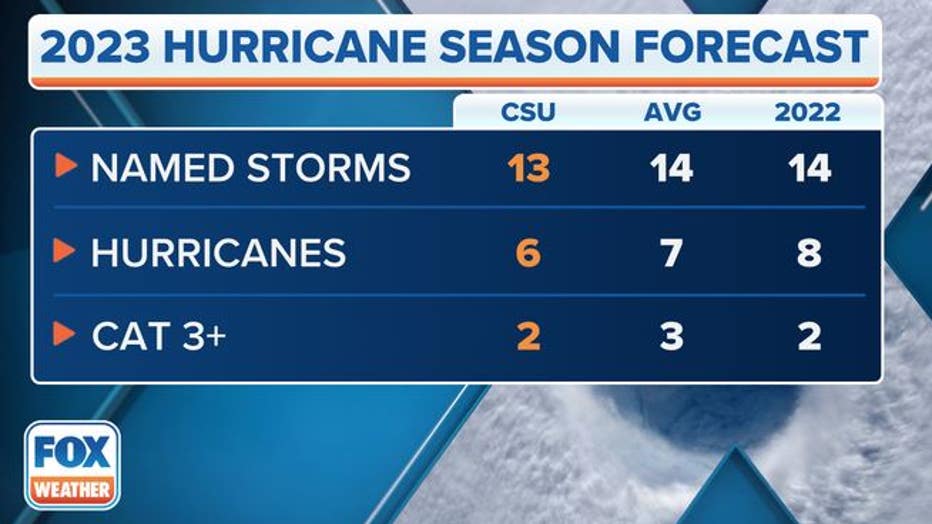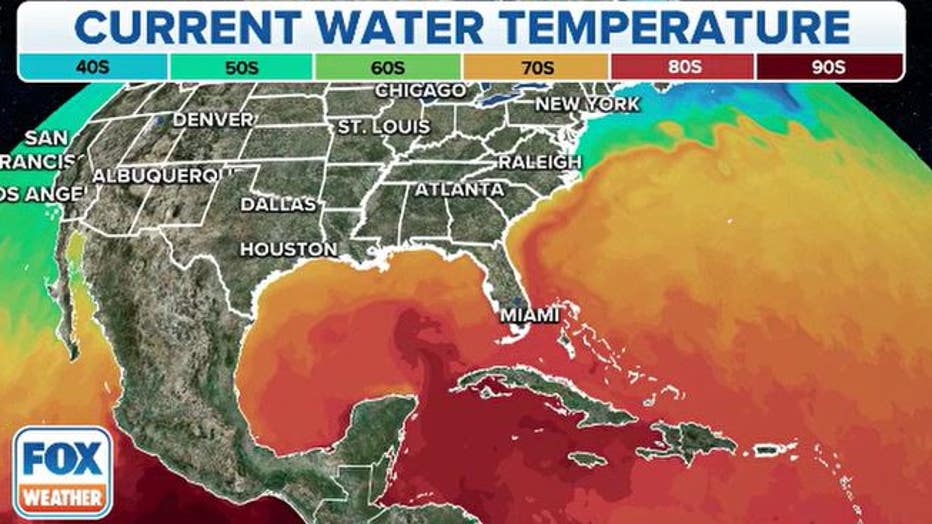Experts predict slightly below-average hurricane season in Atlantic due to expected El Nino influences

Experts predict below average hurricane season: What does that mean?
FOX Weather's Brian Norcross explains Colorado State University's initial predictions for the 2023 Atlantic Hurricane Season. CSU's prediction is that there will potentially be a below average season.
ORLANDO, Fla. - The hurricane experts at Colorado State University expect tropical cyclone activity to be slightly below average in the Atlantic basin during the 2023 hurricane season.
Phil Klotzbach, the lead author of the forecast, released the information at the National Tropical Weather Conference in Texas on Thursday morning.
The CSU tropical weather outlook calls for 13 named storms, six of which could become hurricanes with at least 74 mph winds. Klotzbach said that two of the hurricanes could be major (Category 3 or higher) with winds of at least 111 mph.

Colorado State University expects the 2023 Atlantic hurricane season to be slightly below average, with only 13 named storms.(FOX Weather)
Why aren't forecasters expecting a busy hurricane season?
After a rare triple dip La Niña, the state of the Pacific is considered to be neutral, which could have wide implications on how busy the Atlantic season is.
"It's April. There's a lot of uncertainty, but this year I think there's even more, and that's because you know we've been in this La Niña pattern for about three years, and that pattern is finally broken down," Klotzbach told FOX Weather.
Klotzbach noted that while the transition from neutral to an El Niño is the primary cause for the slightly less busy hurricane season outlook, other conditions at play could sway from a true El Niño-type setup.
"It's certainly looking like we have the potential for potentially a pretty robust El Niño event this summer and fall," he said. "However, at the same time, the Atlantic right now, in the tropical and subtropical Atlantic, is really, really warm."

A look at the Atlantic and Gulf of Mexico water temperatures in mid-April. (FOX Weather)
Warmer than average water temperatures are one of the main ingredients that can lead to enhanced organization and tropical cyclone formation.
"So it's kind of this tug of war between those two factors, which is why our final forecast is for a little below normal, just out of respect for potentially a quite robust El Niño event," Klotzbach said.
The hurricane expert said that even if an El Niño were to dominate, there's still potential for an active season.
FOX Weather's Hurricane Specialist Bryan Norcross agrees with Klotzbach and warns that those within hurricane zones should always be prepared no matter what's forecast.
"Seasonal forecasts issued in April are iffy because the future state of El Niño is always uncertain. It slowly becomes clearer closer to summer. And this year, the forecast is even less certain than normal because a strong, hurricane-limiting El Niño is just one of a range of possibilities, which include a fairly busy season," Norcross said. "The bottom line is, the forecasts are interesting but have nothing to do with how people in the hurricane zone should prepare for the season."
How does a ‘slightly below-average season’ compare to past hurricane seasons?
CSU experts looked back at past hurricane seasons and found similarities on which to base their forecast.
"So far, the 2023 hurricane season is exhibiting characteristics similar to 1969, 2002, 2004, 2006, 2009, 2012, 2014 and 2015," CSU forecasters said.
"These years span a range of ENSO conditions from warm neutral ENSO to robust El Niño, as well as from near-normal (sea surface temperatures) in the tropical Atlantic to well-above-average (sea surface temperatures) in the tropical Atlantic," Klotzbach said.
Klotzbach cautioned that there is considerable uncertainty behind the initial outlook.

Seminole County residents still struggling six months after Hurricane Ian
Hurricane Ian hit Central Florida six months ago and some people in Seminole County are still struggling.
CSU experts expect 2023 hurricane activity to come in around 80% of an average season. By comparison, tropical cyclone activity in 2022 was about 75% of the average season.
"The 2022 hurricane season will be most remembered for its two major hurricanes: Fiona and Ian," CSU forecasters said. "Fiona brought devastating flooding to Puerto Rico before causing significant surge, wind and rain impacts in the Atlantic Provinces of Canada as a post-tropical cyclone. Ian made landfall as a Category 4 hurricane in southwest Florida, causing over 150 fatalities and $113 billion in damage."
Klotzbach and his team plan to issue outlook updates periodically throughout the hurricane season.
The Atlantic hurricane season officially begins on June 1 and ends on November 30.

